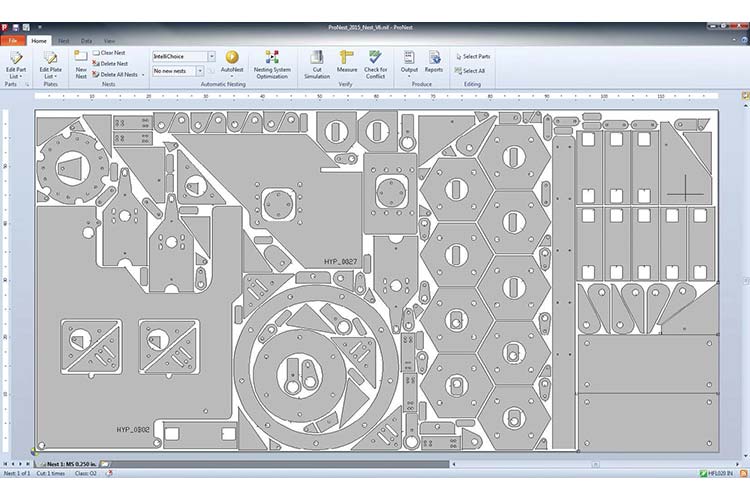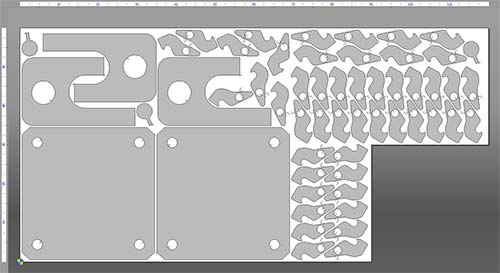CAM Nesting Software for Modern Manufacturing
Over the years, manufacturing processes have progressed steadily with the advent of technology. From an initial reliance on physical labour, manufacturers today are increasingly turning to more sophisticated means in their pursuit for efficiency and better results.
One of the main computer-aided manufacturing (CAM) applications in metalworking is nesting;the process of arranging cut profiles within a given area (typically on a flat metal sheet) to maximise material utilisation. The nesting software analyses the parts to be produced and, with the use of proprietary algorithms, determines the best way of laying out these parts with minimum raw material waste. Nestingis often used in industrial manufacturing processes, such as the manufacture of metal parts for machinery.
Changing requirements in modern nesting
In the past, the concept of nesting merely involved filling a metal sheet with cut profiles, but along with technological advancements and increasing demands for productivity, this concept has evolved. The complexities of modern manufacturing meant that the nesting process is now more than just a simple geometric problem of arranging parts on a sheet. And often times, nesting in sheet metal poses far greater challenges, compared to other industries, for three main reasons:
Complexity of parts
Machinery parts are often complex and irregular in shape. Furthermore, modern manufacturers may have nesting jobsthat consist of a mix of parts for different customers. The angle of rotation of the various parts also has to be considered during nesting to ensure correct metal grain direction, while also providing effective material utilisation.
Different sheet sizes
Today, sheet metal is available in a wide selection of stock sizes. Depending on job requirements, manufacturers may have to work with sheet metal of varying dimensions. At times, in order to minimise waste, manufacturers may even choose to cut smaller parts from sheet remnants, which are often irregular in shape.
Maximising both sheet utilisation & time
For a given set of metal and parts to be cut, there will be various nest options available, even without considering part rotation. The challenge lies in identifying a particular nest that provides the optimal balance of sheet utilisation and cutting time.
Manufacturers are increasingly adopting a lean manufacturing approach for optimal efficiency and cost savings. This demand for greater productivity, coupled with the above-mentioned challenges, have led to the need for more sophisticated nesting software that can offer additional benefits.One such software is Hypertherm’s ProNest®, an industry leading CAD/CAM nesting software for advanced mechanised cutting.
Advancements in nesting software
Compared to traditional nesting software, advanced nesting options confer several major benefits that ultimately lead to increased efficiency, better cut quality, and an overall improvement in the manufacturing process.
Materials optimisation
For manufacturers, keeping production costs low is always a priority, and one of the ways to achieve this is by maximising usage of materials. By considering the actual shape of the cut profiles (both regular and irregular) before nesting, advanced software are capable of automatically developing a layout of selected parts on the sheet metal, with optimal part spacing and orientation to maximise plate utilisation.The software is also intuitive enough to utilise spaces with in existing parts (Figure 1).

Furthermore, operators can easily create remnants, either cropping the plate and saving them electronically in the software, orby entering the dimensions of an irregular plate found in the manufacturing facility and adding these dimensions to create a remnant for immediate or future nesting (Figure 2). This way, leftover material can be re-used for other jobs. Software such as ProNest also have additional capabilities that make advanced-level nesting decisions based on the parts available. This way, manufacturers face fewer challenges when identifying the nest that gives the best sheet utilisation, as the software is capable of selecting theoptimal nesting option.With nesting software that offers such capabilities, manufacturers will be able to utilise materials more efficiently during the manufacturing process.

Increased productivity
While efficient nesting is desirable, having the ability to cut these nests productively is another important consideration. Different continuous cutting functions that connect two or more profiles to form a single cutting path are now incorporated into some advanced nesting software, allowingmanufacturers to cut their nests with ease. For example, common line cutting arranges and joins any number ofparts, with one or more straight edge,together so that the parts can be cut with a common line (Figure 3). Chain cutting provides a way of linking a variety of parts with a continuous cut, whereas bridge cutting allows two or more parts to be linked by a thin web of material (bridge). Besides increasing productivity, these processes also reduce the pierce cycle, which saves time, extends consumable life, and lowers production costs.
Better part quality
With advanced nesting software, process-specific parameters like pierce rate, feed rate, and kerf compensation can be varied during the cutting process. All these factors contribute to cut pieces with improved edge quality, reduced dross, reduced hole taper, and sharper corners.
Apart from simply laying out cut profiles during nesting, some software comes with additional features that are capable of detecting nesting conflicts and job errors. These pre-cutting checks ensure that the job is properly completed the first time, thereby avoiding the need for secondary processes like grinding.
Versatility
Within a single manufacturing facility, cutting processes may differ from job to job, based on the material thickness or job requirements. For advanced nesting software, application is not limited to a single cutting process as the technology is compatible with multiple cutting processes, including plasma, laser, oxyfuel, waterjet, or combination punch, regardless of cutting machine brand and model. In addition, some nesting software allow operators to have control over advanced metal cutting applications like bevel and hole cutting, with specialised built-in support that enables these features to be utilised automatically without operator intervention. Manufacturers will thus be able to consolidate all cutting processes into a single software solution, so less time and resources are required for software training.
When it comes to nesting software requirements, there is no ‘one size fits all’ solution, as cutting needs can vary greatly, even within a single manufacturing facility. Hence, the appeal of advanced nesting software lies in its modular structure, as manufacturers are given the option to customise their software, including only the features and modulesthat they require. This versatility translates to greater cost savings for manufacturers in the long run.
Integration
In order to fully utilise the benefits of nesting software in a modern manufacturing environment, integration with other corporate business systems within an organisation is vital.Today’s advanced nesting software offersquick and seamless integration with most Enterprise Resource Planning (ERP)/Manufacturing Resource Planning (MRP) solutions through data sync capabilities that provide fuss-free plug-and-play integration. For instance, work order processing allows operators to process work orders, such as parts grouping and tracking, directly from within the nesting screen, instead of relying on manual input. When integrated with a plate inventory system,a good nesting software will allow manufacturers to effectively managetheir sheet inventory, while ensuring that only availablematerials are used. These are just some ways in which advanced nesting software can contribute to a lean manufacturing business approach.
Conclusion
Nesting software has come a long way since it was first developed, and today, it is no longer sufficient to view it as a purely geometric solution. Advancements in technologies have opened up a new array of possibilities in nesting processes that touch on increasingly more aspects of a manufacturing business. For companies looking to achieve a lean manufacturing approach, advanced nesting software like Hypertherm’s ProNest can add considerable value to a business and assist manufacturers in achieving high quality end products with greater efficiency and cost savings.
Author: Tom Stillwell, Sr. Marketing Specialist, Hypertherm CAM Software Team



